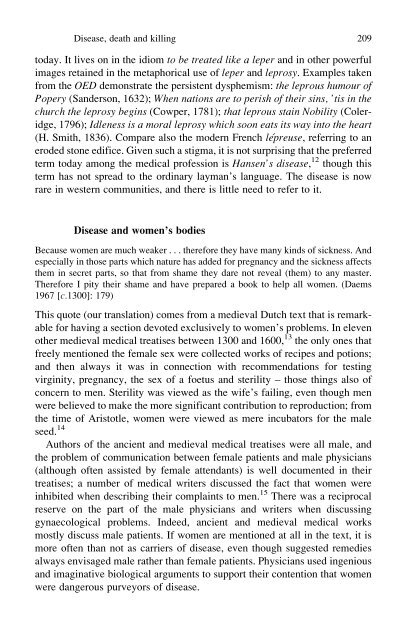Forbidden Words: Taboo and the Censoring of Language
Forbidden Words: Taboo and the Censoring of Language
Forbidden Words: Taboo and the Censoring of Language
You also want an ePaper? Increase the reach of your titles
YUMPU automatically turns print PDFs into web optimized ePapers that Google loves.
Disease, death <strong>and</strong> killing 209<br />
today. It lives on in <strong>the</strong> idiom to be treated like a leper <strong>and</strong> in o<strong>the</strong>r powerful<br />
images retained in <strong>the</strong> metaphorical use <strong>of</strong> leper <strong>and</strong> leprosy. Examples taken<br />
from <strong>the</strong> OED demonstrate <strong>the</strong> persistent dysphemism: <strong>the</strong> leprous humour <strong>of</strong><br />
Popery (S<strong>and</strong>erson, 1632); When nations are to perish <strong>of</strong> <strong>the</strong>ir sins, ’tis in <strong>the</strong><br />
church <strong>the</strong> leprosy begins (Cowper, 1781); that leprous stain Nobility (Coleridge,<br />
1796); Idleness is a moral leprosy which soon eats its way into <strong>the</strong> heart<br />
(H. Smith, 1836). Compare also <strong>the</strong> modern French lépreuse, referring to an<br />
eroded stone edifice. Given such a stigma, it is not surprising that <strong>the</strong> preferred<br />
term today among <strong>the</strong> medical pr<strong>of</strong>ession is Hansen’s disease, 12 though this<br />
term has not spread to <strong>the</strong> ordinary layman’s language. The disease is now<br />
rare in western communities, <strong>and</strong> <strong>the</strong>re is little need to refer to it.<br />
Disease <strong>and</strong> women’s bodies<br />
Because women are much weaker . . . <strong>the</strong>refore <strong>the</strong>y have many kinds <strong>of</strong> sickness. And<br />
especially in those parts which nature has added for pregnancy <strong>and</strong> <strong>the</strong> sickness affects<br />
<strong>the</strong>m in secret parts, so that from shame <strong>the</strong>y dare not reveal (<strong>the</strong>m) to any master.<br />
Therefore I pity <strong>the</strong>ir shame <strong>and</strong> have prepared a book to help all women. (Daems<br />
1967 [c.1300]: 179)<br />
This quote (our translation) comes from a medieval Dutch text that is remarkable<br />
for having a section devoted exclusively to women’s problems. In eleven<br />
o<strong>the</strong>r medieval medical treatises between 1300 <strong>and</strong> 1600, 13 <strong>the</strong> only ones that<br />
freely mentioned <strong>the</strong> female sex were collected works <strong>of</strong> recipes <strong>and</strong> potions;<br />
<strong>and</strong> <strong>the</strong>n always it was in connection with recommendations for testing<br />
virginity, pregnancy, <strong>the</strong> sex <strong>of</strong> a foetus <strong>and</strong> sterility – those things also <strong>of</strong><br />
concern to men. Sterility was viewed as <strong>the</strong> wife’s failing, even though men<br />
were believed to make <strong>the</strong> more significant contribution to reproduction; from<br />
<strong>the</strong> time <strong>of</strong> Aristotle, women were viewed as mere incubators for <strong>the</strong> male<br />
seed. 14<br />
Authors <strong>of</strong> <strong>the</strong> ancient <strong>and</strong> medieval medical treatises were all male, <strong>and</strong><br />
<strong>the</strong> problem <strong>of</strong> communication between female patients <strong>and</strong> male physicians<br />
(although <strong>of</strong>ten assisted by female attendants) is well documented in <strong>the</strong>ir<br />
treatises; a number <strong>of</strong> medical writers discussed <strong>the</strong> fact that women were<br />
inhibited when describing <strong>the</strong>ir complaints to men. 15 There was a reciprocal<br />
reserve on <strong>the</strong> part <strong>of</strong> <strong>the</strong> male physicians <strong>and</strong> writers when discussing<br />
gynaecological problems. Indeed, ancient <strong>and</strong> medieval medical works<br />
mostly discuss male patients. If women are mentioned at all in <strong>the</strong> text, it is<br />
more <strong>of</strong>ten than not as carriers <strong>of</strong> disease, even though suggested remedies<br />
always envisaged male ra<strong>the</strong>r than female patients. Physicians used ingenious<br />
<strong>and</strong> imaginative biological arguments to support <strong>the</strong>ir contention that women<br />
were dangerous purveyors <strong>of</strong> disease.

















